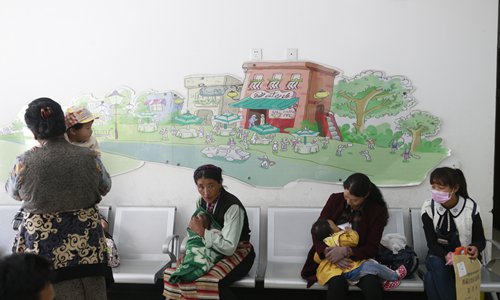
Parents line up outside the pediatrics department in Tibet People's Hospital in Lhasa in June. (Photo/GT)
When Wang Tao first went to Tibet's Nagqu, he couldn't believe how backwards its medical services and resources are.
Wang is a doctor at the Children's Cardiovascular Center of the West China Women and Children's Hospital and he went to Tibet for the first time this April to help with medical checkups.
There were seven people in his team and they brought their own medical equipment, such as ultrasound machines, because local hospitals aren't sufficiently equipped to meet all the population's medical needs.
Because Tibet's herdsmen live in scattered communities in remote regions, Wang and his peers used schools as checkup hubs and checked 4,000 children within two weeks, finding 40 cases of congenital heart disease. The children were then transferred to larger hospitals to be treated.
Cooperation between Tibetan hospitals and out-of-region hospitals to treat local children with heart problems has existed for several years. Because of the high altitude and climate, children in Tibet have always suffered from a relatively high rate of heart disease. At the same time, hospitals on the plateau generally aren't as advanced in terms of technology and resources as those in other regions.
There has been some grass-roots cooperation on heart disease since as early as 2008. In 2012, the central government decided to provide funds so all children in Tibet could be treated for free, as well as to provide a foundation for more mature cooperation between hospitals in Tibet and other provinces.
Inherently insufficient
Children in Tibet are especially prone to heart disease because of the environment and weather, said Shan Minna, director of the department of pediatrics at the Tibet People's Hospital in Lhasa
An official who was assigned to Tibet for a three-year stint previously told the Global Times that he gradually found himself facing lots of health issues. He couldn't get used to the high attitude and had to carry an oxygen tank with him at all times. When he was not inhaling oxygen from the tank, he found his heart would beat faster and sometimes felt discomfort.
It's not a rare issue. Many of his peers from other regions have found themselves developing all sorts of diseases, one even said his organs have become larger since he moved to Tibet.
It's the same for local Tibetans. They are also affected by the weather and environment, and have taken on the weather at the expense of their health. Data from 2015 shows that the average life span in Tibet is 68, while the national average is 75.
"In the field of congenital heart disease, data shows 0.4 to 0.8 percent of children are born with these conditions in low-lying areas, but in high-altitude plateaus, it's 1 to 1.3 percent, almost twice as high," Shan said.
But in these regions, medical techniques as well as resources are lacking, Hua said. Often he and his team had to give lectures to the local doctors and train them on the newest technologies developed outside Tibet.
Furthermore, people in these relatively underdeveloped regions also lack knowledge about health.
"Early congenital heart disease has very subtle symptoms, such as irregular breathing patterns, or immature growth, children with these conditions might appear smaller than others their age and not as strong," said Hua. "But in the Tibetan regions, many parents are not equipped with enough knowledge to recognize these signs."
If the signs are spotted early on and the children have operations right away, the disease can be cured. But if one misses these signs and lets the disease develop to its latter stages, there's little doctors can do, and it can even threaten children's lives. In fact, congenital heart disease is one of the top killers of children under 5 in China.
During checkups in the field, his team found that this problem is all too common. Often they come across children with severe heart disease of which the parents have no knowledge, and many are surprised to find out their children are ill.


















































